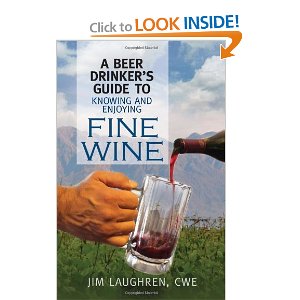
by Lorri | Jan 7, 2015 | UnCorked
The language of wine may be one of the most frustrating aspects of learning about wine for new wine drinkers. Fruity, flabby, acidic, firm, rich and fresh are just a few of the terms thrown around. I remember one of my first wine classes in London when my instructor described a wine with deep serious observance as smelling of “barnyard manure.” At the time I never would have guessed the phrase would be used to describe one of the finest wines I have ever had the honor to drink later in life … aged Burgundy.
Over the years the language of wine became a personal obsession, as I was constantly learning and unraveling exactly how to describe a wine. I think wine lovers may be one of the largest groups of underground geeks. We smell everything, read anything with the word wine involved and we will share a glass of wine with 10 people in the room just to get a taste.
Wine terminology isn’t as confusing as it seems if we stop to consider the words are simply memorable ways to describe specific smells and tastes and other traits. These are a few of the more interesting terms in our wine world.
Cat’s pee on a tomato bush
I know, not words you want associated with something you’re about to drink, but this description is spot-on for the distinctive smell of most sauvignon blanc. Other words used to describe the grape include “flinty,” “grassy” and “gun smoke.”
Flabby
Another confusing term if your first thought is of untoned muscle. This term is actually used to describe a wine too low in acidity.
Dumb
It isn’t an insult to the wine’s intelligence, but describes a wine with undeveloped aromas. Usually the description refers to a very young wine in a certain stage of aging.
Clean
This means there are no off flavors or aromas in the wine.
Hot
While it’s true a wine served too warm could be called hot, this actually refers to the alcohol and balance of a wine. Unbalanced, high-alcohol wines can be hot in that they create a burning sensation in the mouth.
Legs or tears
This is one of my favorite wine terms, but it is also possibly one of the most misunderstood phrases in wine language. This term is not a visual measure of quality but of alcohol content. Legs and tears refers to the colorless streams left on the inside of your glass when you swirl the wine around. The slower the streams fall and the thicker they are is usually a sign of higher alcohol.
by Lorri | Aug 7, 2013 | UnCorked
 I just finished an interesting book for the die-hard beer drinkers out there: A Beer Drinker’s Guide to Knowing and Enjoying Fine Wine by James Laughren. The book encourages the beer drinker to embrace getting to know the other fermented beverage. Laughren clears a path through the wine world with tips “hidden among nuggets of beer lore, the secret tips for appearing extra wine smart while building your knowledge.”
I just finished an interesting book for the die-hard beer drinkers out there: A Beer Drinker’s Guide to Knowing and Enjoying Fine Wine by James Laughren. The book encourages the beer drinker to embrace getting to know the other fermented beverage. Laughren clears a path through the wine world with tips “hidden among nuggets of beer lore, the secret tips for appearing extra wine smart while building your knowledge.”
I am by no means a beer expert, but with a little research and tasting opportunities I put together a few styles of beer easily complementing a wine style.
If you like pale ale you may like pinot noir. Pinot noir is a lighter red wine without the heavy tannic bite you usually get from fuller bodied wines. Also similar to beer, pinot noir’s light style makes it easy to serve chilled.
THE VALUE
- 2011 Gnarly Head Pinot Noir, California (about $12 retail)
THE SPLURGE
- 2011 A to Z Oregon Pinot Noir, Oregon (about $22 retail)
If you like light beer or American lager, you may like brut cava. Both are bubbly and refreshing and easily pair with a variety of foods.
THE VALUE
- NV Freixenet Brut Cava, Spain (about $10 retail)
THE SPLURGE
- NV Sumarroca Brut Cava, Spain (about $18 retail)
If you drink IPA (India Pale Ale), you may like carmenere. Carmenere has a balance of savory, bitter and fruity.
THE VALUE
- 2011 Root 1 Carmenere, California (about $12 retail)
THE SPLURGE
- 2011 La Playa Axel Carmenere, Chile (about $26 retail)
If you drink wheat beer you may like a buttery rich chardonnay. Chardonnay offers a quenching, refreshing taste that always has a creamy smooth texture similar to a wheat beer.
THE VALUE
- 2011 Butternut Chardonnay, California (about $16 retail)
THE SPLURGE
- 2011 La Crema Sonoma Chardonnay, California (about $26 retail)
by Lorri | Jun 13, 2012 | UnCorked
Wine drinking, ideally, is a never-ending journey in trying new tastes and discovering new flavors.
Most of us are familiar with the white wine lineup of chardonnay, sauvignon blanc and Riesling but there are many more whites to explore. Some of the most alluring whites in the world are hidden behind confusing labels. Often these wines are identified by region rather than grape.
A note about this weeks recommendations: The designations of value and splurge are relative to the specific regions and are not necessarily based on price.
ENTRE-DEUX-MERS, BORDEAUX, FRANCE
These aromatic wines are mostly made with sauvignon blanc, semillon and a small addition of ugni blanc and muscadelle. At its best, it tastes zippy and refreshing with layers of distinct aromas of lemon, lime and fresh-cut grass. This region covers a huge area so there is a largerange of prices and quality.
THE VALUE
- 2011 Domaine Sainte-Anne Entre-Deux-Mers Blanc, France (about $15 retail)
THE SPLURGE
- 2011 Chateau Bonnet Blanc, France (about $19 retail)
CHABLIS, BURGUNDY, FRANCE
Chablis is made from the very familiar chardonnay grape. Characteristics of chablis can range from steely mineral to fruity apple flavors due to the variations inthe use of oak in maturing the wines.
THE VALUE
- 2010 Joseph Drouhin Chablis, France (about $25 retail)
THE SPLURGE
- 2010 Joseph Faiveley Chablis, France (about $38 retail)
ORVIETO, UMBRIA, ITALY
Orvieto is made from the trebbiano grape and usually an array of other Italian whites are added into the blend. In the past, it was known as a sweetish style of wine using noble rotten grapes but the more modern styles are generally dry. It is aromatic with fresh, lemony fruit and the occasional hint of almond.
THE VALUE
- 2011 Ruffino Orvieto, Italy (about $10 retail)
THE SPLURGE
- 2011 Villa Antinori Orvieto, Italy (about $14 retail)
POUILLY-FUME, LOIRE VALLEY, FRANCE
This crisp French white is made from the well-known sauvignon blanc grape. It is bone dry and has much less acidity than its zippy New Zealand rival. Famous for its smoky, gunflint flavor, it is layered with fresh lemon, mineral and floral aromas.
THE VALUE
- 2010 Sauvion Pouilly-Fume, France (about $35 retail)
THE SPLURGE
- 2010 Ladoucette Pouilly-Fume, France (about $45 retail)
by Lorri | Jun 6, 2012 | UnCorked
“There’s a place and a time for everything,” the saying goes.
There’s also a wine.
From everyday wines to once-in-a-lifetime rare vintages, there’s a wine for almost every occasion.
A well-chosen everyday wine can enhance our dayto-day meals. It may be enjoyed with last night’s leftovers, paired with sloppy Joes at the kitchen counter or poured for no other reason than it’s Wednesday. For these wines, most of us are seeking the best value — wines we can serve with confidence that won’t break the bank or even pinch the budget.
For the best savings, buy by the case, check for instore specials or shop on a retailer’s “wine day.” When a favorite goes on special, be sure to stock up. These tips can land you an everyday drinking wine well below the everyday retail price.
THE VALUE
- 2011 Red Rock Merlot, California (about $10 retail)
THE SPLURGE
- 2011 McManis Cabernet Sauv i g n o n, California (about $15 retail)
For birthdays and anniversaries, we often turn to our favorite once-a-year wines. These are bottles that mark special occasions and memorable moments while still keeping on budget.
For savings, look to substitute vintage Champagne with blanc de blanc, cabernet sauvignon with malbec, pinot noir with merlot and vintage port with late-bottled vintage port.
THE VALUE
- NV Schramsberg Winery Blanc de Blancs, California (about $40 retail)
THE SPLURGE
- 2007 Bell Napa Valley Claret, California (about $69 retail)
The most meaningful moment for many wine lovers is savoring the once-in-a-lifetime wine. For one it may be Bordeaux; for another, a 100-year-old Sauternes Yquem. The wine itself is the reason for the celebration. For those lucky enough to have their own cellared stash, these wines are awaiting patiently. But for most of us the best opportunities to experience a once-in-a-lifetime wine may be found at a winery tasting room, tasting events, restaurant wine lists or on a shelf at your local fine wine retail shop.
THE VALUE
- 2008 Duckhorn Vineyards Three Palms Merlot, California (about $98 retail)
THE SPLURGE
- 2005 Chateau Lascombes Margaux, France (about $158 retail)
by Lorri | May 16, 2012 | UnCorked
The 2004 film Sideways may have brought Santa Barbara wine country to the mainstream consciousness, but the terroir continues to drum up demand from around the world.
If you’ve ever been in a vineyard in the Santa Rita Hills on a summer afternoon, when the distinct, chilling, crisp wind blows in from the Pacific Ocean, you understand the key to Santa Barbaras terroir.
This region, a designated American Viticultural Area, is distinguished by its east west orientation from the coast, with valleys opening directly to the ocean. This unique landscape allows an ebb and flow of fog and ocean breezes that shape the distinct microclimates responsible for the idyllic cultivation of world-class wines.
Moving inland, temperatures rise for a growing season that most people would consider warm. These conditions make the region ideal for cabernet sauvignon and merlot.
The diverse climate means the region produces a variety of wines, especially those that thrive on long, slow, cool growing seasons like pinot noir, syrah and chardonnay.
THE VALUES
- 2011 Firestone Riesling, California (about $13 retail)
- 2011 SeaGlass Santa Barbara County Chardonnay, California (about $12 retail)
- 2011 Hayman and Hill Santa Barbara Pinot Noir, California (about $14 retail)
THE SPLURGES
- 2009 Fess Parker Santa Barbara Syrah, California (about $22 retail)
- 2009 Tantara Bien Nacido Old Vine Pinot Noir, California (about $56 retail)
- 2010 Cambria Katherines Vineyard Chardonnay, California (about $25 retail)
- 2009 Foxen Julias Vineyard P i not Noir, California (about $57 retail)

 I just finished an interesting book for the die-hard beer drinkers out there: A Beer Drinker’s Guide to Knowing and Enjoying Fine Wine by James Laughren. The book encourages the beer drinker to embrace getting to know the other fermented beverage. Laughren clears a path through the wine world with tips “hidden among nuggets of beer lore, the secret tips for appearing extra wine smart while building your knowledge.”
I just finished an interesting book for the die-hard beer drinkers out there: A Beer Drinker’s Guide to Knowing and Enjoying Fine Wine by James Laughren. The book encourages the beer drinker to embrace getting to know the other fermented beverage. Laughren clears a path through the wine world with tips “hidden among nuggets of beer lore, the secret tips for appearing extra wine smart while building your knowledge.”